Santhosh Padmanabhan
Education as we see it today has been compartmentalized into various labels. Over the years, there has been a concerted effort to further divide the learning of a child into specialized focus areas. But, as humans, do we function that way? Our body is closely connected with the mind as our emotions are with the understanding of the world around us. Sports include any physical activity, not necessarily competitive, that engages the participant so as to improve physical ability and skills, while providing entertainment. Thus, having fun in the classroom, physically moving around or jumping so as to learn more about yourself and the world around can also be ‘sports’.
Communities have not seen sports or physical activity as distinct from learning from other means until in the recent past. Learning through experience does entail the use of all senses and not just those of sight or hearing. A schooling system that can see sports and physical activity as being an integral part of the classroom and the life of its children and staff creates a healthy community that learns joyfully with cooperation.
Movement and sensory integration in the classroom
“The brain, the organ that is responsible for your conscious experience, is an eternal prisoner in the solitary confinement of the skull…and must rely on information smuggled into it from the senses…the world is what your brain tells you it is, and the limitations of your senses set the boundaries of your conscious experience.” – Coren, Porac & Ward, Sensation and perception (1984, p2).
Every educator needs to question if the child is indeed learning through every means their existence intends to provide. In our effort to standardize education to create a workforce for various duties that we have created, have we failed to recognize humans as capable of understanding and experiencing the world through body, mind and soul? As a child grows up, learning happens through various senses – sight, sound, smell, taste, touch, tactile, proprioceptive (sense of pressure), vestibular (sense of balance) and other senses.
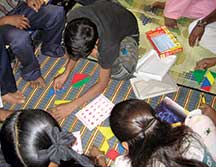 A classroom where the child just sits and listens to the teacher curbs the child’s ability to learn through a multitude of ways. In the schools we are a part of, physical activity, dance, theater and games involving movement are all important learning tools as are reading, writing and using a computer or other learning aids. Here is an example – when learning about different shapes, we took the children outside class to let them run around to identify shapes in and around the school. In another class we let them draw shapes on the ground, and played a game where kids ran to identify the shapes called out. Then, they jumped from one shape to the other. A blindfolded child was given shapes to touch and feel so as to identify it rightly. The children made different shapes out of clay to enhance their tactile sensory input. Thus, the children engaged in many different ways to learn about shapes.
A classroom where the child just sits and listens to the teacher curbs the child’s ability to learn through a multitude of ways. In the schools we are a part of, physical activity, dance, theater and games involving movement are all important learning tools as are reading, writing and using a computer or other learning aids. Here is an example – when learning about different shapes, we took the children outside class to let them run around to identify shapes in and around the school. In another class we let them draw shapes on the ground, and played a game where kids ran to identify the shapes called out. Then, they jumped from one shape to the other. A blindfolded child was given shapes to touch and feel so as to identify it rightly. The children made different shapes out of clay to enhance their tactile sensory input. Thus, the children engaged in many different ways to learn about shapes.
 Running coaches would identify the term ‘interval training’ wherein athletes are made to sprint short distances and then given a rest in between for the heart rate to come back to normal. This is primarily done to improve lung capacity and breathing. The same training could be imparted as a game in any class. For e.g., when learning a language or any concept, children could be picking simple clues from a bucket with short sprints back and forth. In the resting time, the child solves the clue to piece together a new word or concept. When we need to deal with repetition so as to help reiteration of concepts, such games could make it fun and interesting.
Running coaches would identify the term ‘interval training’ wherein athletes are made to sprint short distances and then given a rest in between for the heart rate to come back to normal. This is primarily done to improve lung capacity and breathing. The same training could be imparted as a game in any class. For e.g., when learning a language or any concept, children could be picking simple clues from a bucket with short sprints back and forth. In the resting time, the child solves the clue to piece together a new word or concept. When we need to deal with repetition so as to help reiteration of concepts, such games could make it fun and interesting.
Learning about the body through the body
In one of the schools, along with the teacher, we helped children understand and learn more about the anatomy, physiology and functioning of the human body through carefully designed activities that engaged various senses. The activities also drew a correlation to what they observed in their day-to-day lives and their own training as runners. The children could apply what they learned in the field or outside to the interactions in the classroom and could better understand the various exercises or activities outside because of the deeper discussions in the classroom. The teacher wrote a detailed report of the entire year of activities which can be accessed here – http://www.ashanet.org/projects-new/documents/926/Kamala_fellowship_report.pdf.
Inclusion and integration
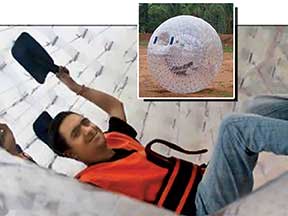 Sports and physical activity is also a powerful way of communicating and promoting inclusion of children from varied backgrounds. In our work with children with neuromuscular or developmental challenges, we designed curriculums for children with cerebral palsy, autism, Down’s syndrome, delayed development and other neuromuscular developmental challenges. We designed a curriculum as a team with special educators and therapists to incorporate various aspects of therapy and living for the children. For children with autism we focused on aspects related to sensory integration, movement and social interaction. The curriculum introduced a new game periodically while incorporating aspects of therapy or development of specific gross motor or fine motor skills. These games got children on wheel chairs, children with developmental delay or any other challenges together for fun and activity. For example, we used a parachute (a circular sheet of material used to make a parachute) with a group of children with varied abilities to design hundreds of games. In another instance, we played a theater game where groups of children recreated a scene (posing as an image) on a given topic.
Sports and physical activity is also a powerful way of communicating and promoting inclusion of children from varied backgrounds. In our work with children with neuromuscular or developmental challenges, we designed curriculums for children with cerebral palsy, autism, Down’s syndrome, delayed development and other neuromuscular developmental challenges. We designed a curriculum as a team with special educators and therapists to incorporate various aspects of therapy and living for the children. For children with autism we focused on aspects related to sensory integration, movement and social interaction. The curriculum introduced a new game periodically while incorporating aspects of therapy or development of specific gross motor or fine motor skills. These games got children on wheel chairs, children with developmental delay or any other challenges together for fun and activity. For example, we used a parachute (a circular sheet of material used to make a parachute) with a group of children with varied abilities to design hundreds of games. In another instance, we played a theater game where groups of children recreated a scene (posing as an image) on a given topic.
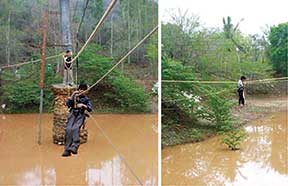 The enthusiasm in the children to participate actively in sports and games grew manifold. Therapy then became a fun activity instead of just a clinical session. The special educators were also inspired to bring in activity and movement to address specific developmental needs of the children in the classroom and outside of it. The educators observed that violence and tantrums reduced, while focus on communication and social interaction improved. We celebrated sports day in a unique manner with the entire school of over 300 children with varied abilities, coming together for various activities and a display that demonstrated cooperation rather than competition. Children went through obstacle courses with amazing tenacity and performed many other physical activities and sports to show the world what they were capable of. No one was judged on their performance, yet children pushed themselves to crawl, roll, jump, run and celebrate with their full vigor.
The enthusiasm in the children to participate actively in sports and games grew manifold. Therapy then became a fun activity instead of just a clinical session. The special educators were also inspired to bring in activity and movement to address specific developmental needs of the children in the classroom and outside of it. The educators observed that violence and tantrums reduced, while focus on communication and social interaction improved. We celebrated sports day in a unique manner with the entire school of over 300 children with varied abilities, coming together for various activities and a display that demonstrated cooperation rather than competition. Children went through obstacle courses with amazing tenacity and performed many other physical activities and sports to show the world what they were capable of. No one was judged on their performance, yet children pushed themselves to crawl, roll, jump, run and celebrate with their full vigor.
Exercise as a community building activity
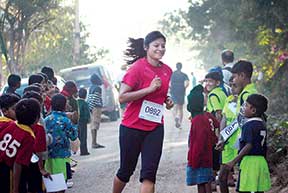 We introduced long distance running (running for 5kms or above) as a regular activity in the lives of children across different schools. We designed a training program incorporating all aspects related to running technique, schedule, nutrition, etc., and trained the children methodically over many months towards a targeted run. The emphasis was on training together and helping each other. The focus was never on competing with each other, but on seeing a better and healthier version of themselves. The schools we worked with included children with or affected by HIV/AIDs, children in remote tribal areas, children with neuromuscular, developmental and physical challenges and children from underprivileged and disadvantaged backgrounds.
We introduced long distance running (running for 5kms or above) as a regular activity in the lives of children across different schools. We designed a training program incorporating all aspects related to running technique, schedule, nutrition, etc., and trained the children methodically over many months towards a targeted run. The emphasis was on training together and helping each other. The focus was never on competing with each other, but on seeing a better and healthier version of themselves. The schools we worked with included children with or affected by HIV/AIDs, children in remote tribal areas, children with neuromuscular, developmental and physical challenges and children from underprivileged and disadvantaged backgrounds.
Running is affordable and accessible to everyone. It doesn’t need fancy equipment and is the most natural way of moving for humans. Introducing kids and staff to running encourages them to maintain a fitness regimen throughout their lives. Even if children are interested in other sport activities, running lays the foundation for all other sports. Long distance running can be used as a tool to steer students to learning important lessons on patience, self-confidence and self-esteem, qualities that will shape the people they become. Running helps children formulate a tangible goal, and when they reach the goal, their belief in being organized and working hard improves tremendously. The most important lesson is that winning is not important – it’s the joy of running and finishing a task together as a community. As the children imbibed these values, they also started receiving recognition. Many children started winning places in big running events with thousands participating from across the country. Also, many children trained by us went on to participate in the Special Olympics at the national level.
Lessons for life from the outdoors
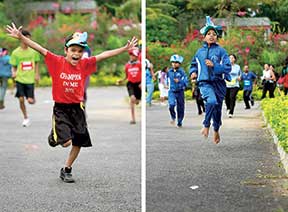 We were also successful in bringing together children from various schools on many occasions. It was simply amazing and a wealth of learning for the children and adults as we experienced what transpired in the interactions. We organized summer camps for many years where children from varied backgrounds lived and interacted together. We organized outbound learning camps, where children drew parallels to real life from outdoor activities as teams. After each activity, observations were made and the children reflected on them to imbibe important lessons on communication, team work, overcoming fear and various other life skills. The children overcame many challenges as a team and also learned to respect each other. Here is the report from one such summer camp – http://tinyurl.com/rh-summercamp-2103.
We were also successful in bringing together children from various schools on many occasions. It was simply amazing and a wealth of learning for the children and adults as we experienced what transpired in the interactions. We organized summer camps for many years where children from varied backgrounds lived and interacted together. We organized outbound learning camps, where children drew parallels to real life from outdoor activities as teams. After each activity, observations were made and the children reflected on them to imbibe important lessons on communication, team work, overcoming fear and various other life skills. The children overcame many challenges as a team and also learned to respect each other. Here is the report from one such summer camp – http://tinyurl.com/rh-summercamp-2103.
The older children took on many responsibilities including those of organizing running events with many hundreds of participants. They started applying the lessons they learned in their life skill curriculum during these events when planning and executing their team’s tasks. Even after graduation, many children continue to train with the running community at large and have incorporated running as part of their lives.
Sports when respected and realized as a way of life, imbibes the values of inclusion, perseverance and compassion. It enables a community to come together and support each other to live a more holistic and meaningful existence.
The author is a student and a coach. He runs to feel alive and enjoys every step and breath that he takes. He aspires to make a meaning out of running rather than see it as numbers or goals. He can be reached at santhosh.padmanabhan@gmail.com.
Runner’s High (www.runnershigh.in) is an effort to inspire children in schools, especially catering to the underprivileged to explore education through running and physical activity. While we found many partner organizations catering to the underprivileged, there was still the question of sustainability. We created a professional and well equipped team of coaches and physiotherapists to offer training programs for a fee for those who could afford it. Our training programs focus on fitness, developing a passion for running and in the process make running a fun and social activity. Thus, Runners High came to life as a social enterprise and not as a non-profit or just a profiteering business.
Some experiences of the schools
1. http://thealternative.in/inclusivity/spocial-revolution-how-ananya-trust-uses-running-to-educate-kids/
2. http://thealternative.in/inclusivity/spocial-revolution-how-this-family-is-beating-autism-by-running/
Schools and efforts we work with
http://www.runnershigh.in/faq/faq.php?answer=57&cat_name= Volunteering%20and%20Runners%20High&category_id=16#57
